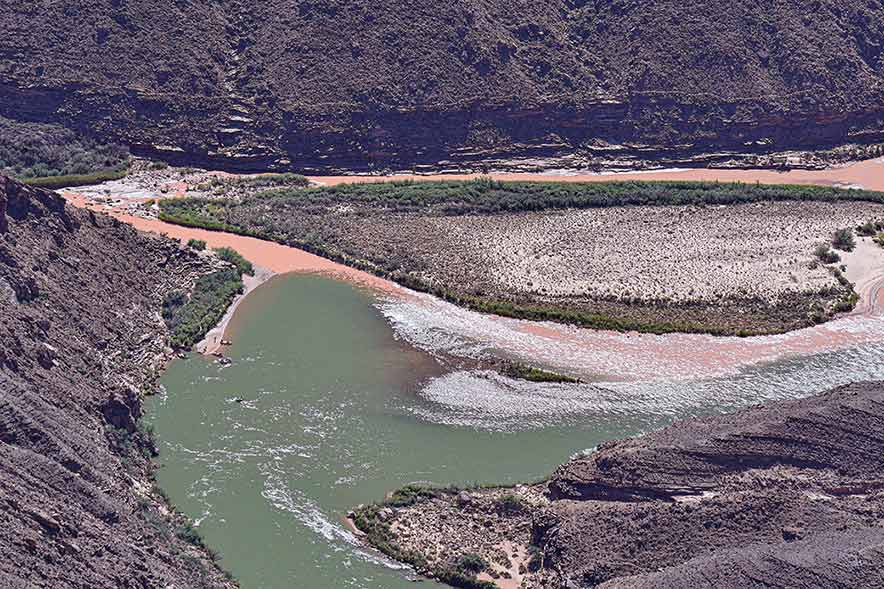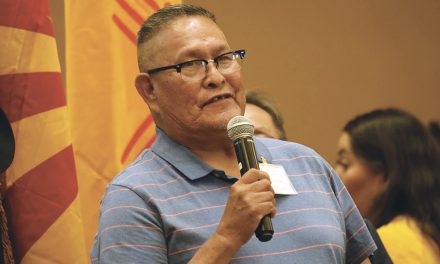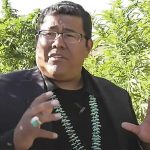
Another developer, another project near the Confluence

Special to the Times | Krista Allen
Developers have applied for permits for a massive hydropower project near the confluence of the Colorado and Little Colorado rivers, shown here, a sacred place to the Diné.
By Krista Allen
Special to the Times
COLORADO RIVER, Ariz.
Families who have ties to Bidáá Ha’azt’i are worried that the Little Colorado River could lose its brilliant shade of turquoise if the latest developer builds four dams and installs equipment in and above Big Canyon.
That is just one of the concerns the families have if Phoenix-based Pumped Hydro Storage gets the green light for its Big Canyon Pumped Storage Project, a hydroelectric power plant that would generate more than 7,000 gigawatt-hours of electricity annually.
The power plant would be located entirely on Diné Bikéyah, in and above Big Canyon, a tributary of the LCR, just 23 miles west of Tónaneesdizí, Arizona. Cultural, traditional, historic, and religious areas along the Colorado and the Little Colorado rivers would not only be desecrated, but also be ravaged by flooding, said Rita Bilagody, who has family ties near the east rim of Bidáá Ha’azt’i, the Grand Canyon.
“It’s going to flood. Everything upriver from there, from the dams,” Bilagody said. “It’s going to alter everything down there. … We have people (who) live down there. That’s their life. That’s how they live and here these developers are coming in.” Another concern is that groundwater depletion would cause wells to run dry, affecting food production and domestic water access.
“We use this groundwater. We have windmills that pump the water and we use that water to water the livestock and we still have people (who) don’t have running water out there,” Bilagody explained. “They’re hauling water for very basic things that they need: Water to drink, water to wash their dishes, wash their clothes …”
Families say this project poses a serious threat to the rivers’ delicate balance of ecosystems, putting pressure on animals and already endangered warm-water, silt-adapted species – the endangered humpback chub, the Colorado pikeminnow, the bonytail chub, and the razorback sucker – that would lose their habitat.
Preliminary permit
Pumped Hydro Storage on March 12 filed an application for a preliminary permit proposing to study the feasibility of the Big Canyon Pumped Storage Project. The sole purpose of a permit, if issued, is to grant the permit holder priority to file a license application during the permit term, according to a June 9 Federal Energy Regulatory Commission notice. A preliminary permit does not authorize the permit holder to perform any land-disturbing activities or to enter lands and waters owned by others without the owners’ express permission.
The project would consist of three dams above Big Canyon: A 450-feet long, 200-feet high concrete arch dam; a 1,000-feet long, 150-feet high earth-filled dam; and a 10,000-feet long, 200-feet high concrete arch dam. Each of these dams would impound a separate reservoir with a combined surface area of 400 acres and a total storage capacity of 29,000-acre feet at a normal maximum operating elevation of 5,390 feet above average mean sea level.
The fourth dam would be in Big Canyon, a 600-feet long, 400-feet high concrete arch dam that would impound a lower reservoir with a surface area of 260 acres and a total storage capacity of 44,000-acre feet at a normal maximum operating elevation of 3,790 feet above msl.
Other structures would include three 10,000-feet long, 30-feet-diameter reinforced concrete penstocks; a 1,100-feet long, 160-feet wide, 140-feet high reinforced concrete powerhouse for nine 400-kilowatt pump turbine generators; three water supply wells with a capacity of 700 horsepower each; a 1,800-feet long, 36-inch-diameter well water supply pipeline; two new double-circuit 500-kilovolt electric transmission lines that connect the project switchyard to the existing 500 kilovolt and 345 kilovolt transmission lines located 14 miles east of the proposed project; and appurtenant facilities.
The estimated annual power generation at the project site would be 7,900 gigawatt-hours, according to Pumped Hydro Storage, which initially named the project the “Navajo Nation Salt Trail Canyon Pumped Storage Project.”
Because the proposed project is not in any way affiliated with the Nation nor did the tribe have any role in the project, the company later omitted the tribe’s name from the project name.
First application
Pumped Hydro Storage on May 8, 2019 first filed an application for a preliminary permit to study the feasibility of the project in Coconino County. But on Aug. 1 that year, the company filed a revised application to address June 19, 2019, comments made by FERC staff.
At that time, the project was comprised of two dams, a 240-feet-high, 500-feet-long upper dam and reservoir and a 140-feet-high, 1,000-feet-long lower dam and reservoir. The project included six 250-megawatt turbine generator units; a 20-mile long, 500-kilovolt transmission line from the powerhouse to the existing Moenkopi switchyard; and five appurtenant facilities.
The estimated annual power generation for the project would have been 3,300 gigawatt hours. “We had a lot of issues on those first two,” explained Steve Irwin, manager of Pumped Hydro Storage, in an interview with the Navajo Times. Some of those issues, he said, were related to the water. “In fact, when we first did them, we were kind of 50-50 whether to do it in the Little Colorado River or in Big Canyon,” he said.
“My partner (Justin Rundle) said, ‘Let’s do it on the LCR. We can always change it if that’s what happens.’ I said OK. Sure enough, we got lots of opposition. As long as we put it in Big Canyon, we got away from all the aquatic and other issues that came up.” Irwin said the company has a temporary permit but when it becomes permanent, the company will pull the application for the Salt Trail Canyon project because of the issues and drawbacks he and Rundle can’t resolve, such as the ancient fish – found only in the Colorado River system – that are now endangered.
Irwin said he and his partner weren’t aware of the water issues that they encountered. “We weren’t anticipating that,” Irwin said. “Unfortunately, with a lot of the water rights stuff, you kind of have to step into it to discover it.”
Big Canyon project
Irwin said the Big Canyon project might be only two dams, “it just depends.”
But if the project goes to its full size, it will be four dams. “Three on the top and one on the bottom, but it could be smaller, it could be half the size,” Irwin said. “We could just have one on the top and one on the bottom. The nice thing about this project is that it can be walked into as needed. “We only have a need for 1,500 megawatts. And later on, if we need to add 500 more megawatts (or) if we need to make the (upper) dam a little taller than the bottom––We might have to add a second reservoir at the top or make the one we have a little taller.”
Irwin said adjustments like these happen at pumped storage projects around the world, such as the Bath County Pumped Storage Station, a 3,003-megawatt capacity project in Virginia, that started out with a generating capacity of 2,100 megawatts. The turbines were upgraded between 2004 and 2009 to reach its present output. “But from what we see, there’s a need for approximately 20,000 gigawatts of storage in the southwestern U.S.,” Irwin explained. “It seems like southwestern U.S. needs about four or five of these projects.”
There are 40 existing projects providing over 22,000 megawatts of storage in the U.S., according to the National Hydropower Association’s Pumped Storage Development Council. The largest projects are in Virginia, Michigan, and in California. And there are 51,310 megawatts representing over 60 pumped storage projects in the FERC queue for licensing and permitting.
Irwin’s and Rundle’s project is just one of them. Irwin said this project would serve the southwestern U.S., providing energy balancing, stability, storage capacity, and ancillary grid services. “From 9 a.m. to 3 p.m. (during) the spring, winter and the fall – nine months out of the year – the price of power goes to zero,” Irwin said. “We’re negative because too much solar is coming on the power grid and basically crushing it. Power should be free on the electric grid by the wholesale price indicator and it needs to be stored.
“What’s happening is a lot of the solar power is just being dumped to the ground,” he said. “They can’t see it. Who’s going to make power for a negative price? Nobody. So, it’s basically going to waste.”
‘A giant battery’
An essential attribute of the country’s electric power system is grid reliability, ensuring that electric generation matches electric demand in real time, according to the National Hydropower Association. The primary challenge in ensuring reliability is that electricity has no shelf life and it must be generated when needed because electricity demand continually changes, especially between daytime periods of peak demand and nighttime periods of low demand.
Electric transmission grid operators have long met this challenge on a real time basis with a limited number of generation technologies, such as hydropower and gas-fired combustion turbines, that have the ability to start up quickly and vary their electric output as the demand changes. NHA’s council believes that these solutions may not be enough as the world moves into a place with far greater amounts of renewable energy on the grid.
Currently, the most common type of energy storage is pumped hydroelectric facilities, which have been utilized for the better part of the last century in the U.S. and around the world, according to the Energy Storage Association. The ESA clarifies that pumped hydroelectric storage facilities store energy in the form of water in an upper reservoir, pumped from another reservoir at a lower elevation.
During periods of high electricity demand, power is generated by releasing the stored water through turbines in the same manner as a conventional hydropower station. And during periods of low demand (usually nights or weekends when electricity is also lower cost), the upper reservoir is recharged by using lower-cost electricity from the grid to pump the water back to the upper reservoir.
“So this would solve the problem and power would have a place to be stored for reuse later,” Irwin explained. “It’s a giant battery is what it is. It’s not a chemical battery, it’s just all potential energy.
“You pump the water up and then you generate the power down and you can recover 85 percent of the power,” he said. “You lose some in evaporation and you lose a little bit in leakage and pump losses.”
Irwin added that a new chemical battery will be about 80 percent efficient. Six months later, it’ll be 65 percent efficient. After three years, it’ll be 50 percent efficient. “Soon after that, it’s going into the junk pile,” said Irwin, who has experience working at a pumped hydroelectric storage facility in South Carolina. “This (hydropower project) will last about 50 to 100 years. There’s really nothing that goes wrong.”
Opposition
Rita Bilagody said the proposed project location would be in the same area where a group of developers from Scottsdale, Arizona, wanted to build the Grand Canyon Escalade Tramway. Eight-person gondolas would have shuttled tourists from the rim to near the Colorado River’s edge where the developers wanted to build a retail complex, a food court, and an amphitheater overlooking the Confluence.
“All of that area is still considered sacred to up to 16 different tribes,” Bilagody said. “And (non-Native developers) are trying to lead people to believe that it’s away from it,” she said. “Physically, it may be a few miles down the river from the Confluence, but it’s still in the same area.
“So the sacred sites that are there, they’re actually all along that whole tributary of the LCR and it’s still held sacred by medicine people from different tribes,” she said. “They still go down there to make offerings.”
The Grand Canyon is a contested canyon where everyday human activities, such as rising tourist numbers, air traffic, mining and development compete. Frank Martin, whose family’s homestead and grazing area is located near the Confluence, said non-Native developers are currently lined up to get access to the rim. He said another developer wants to construct a national scenic byway following the course of the Colorado River, passing through Western Diné Bikéyah.
“The Confluence has always been sacred to the traditional people in the area, those who are not for developing the area,” said Martin, the son of the late Mary J. Martin, a well-known leader and activist in Western Navajo. “My paternal grandmother (Martha Martin) was born on the rim and her father was there before her,” he said. “There is not really anybody actually living on the rim (today).”
Frank Martin said some people, though, do live in the vicinity of the Confluence, where one of his siblings operates a tour business. Bilagody believes Pumped Hydro Storage is taking advantage of the COVID-19 pandemic because the developers know social gatherings of more than 10 people are not permitted at the chapter houses.
“They haven’t really gone down there to do an environmental survey and those are the things that are required by law,” Bilagody said. “And to me, it seems like they are taking advantage of the pandemic because they know we’re not allowed to gather.
“Normally,” she said, “we would be standing together and protesting all of this and be down (near the Confluence). They know we can’t do this. This is how they’re taking advantage of (the pandemic) and trying to ramrod this.”
Tactics of non-Native developers
Bilagody, along with environmentalists and objectors, protested the Escalade for many years before the Navajo Nation Council shot down the measure to build the project in October 2017. “We just got done fighting the Escalade,” Bilagody said as she pointed out the tactics non-Native developers use to discuss projects like the Big Canyon project with Natives.
Bilagody said one of the first tactics of developers is to find someone from the tribe to be a mouthpiece who will say and do what the developers want. For the Escalade, it was former president Albert Hale. “And most times, they are being paid by the developers, which is what we found out with the Escalade,” Bilagody said. “They seem to have a gamebook … of how they proceed with these projects. And these developers know each other. There’s no doubt about it. They talk.”
The second tactic, she says, is convincing Natives the project is entirely for them and being concerned for Native livelihood. The third is the concept of rescuing and helping Natives escape hardship and destitution. “But we see through all of this,” Bilagody said. “First of all, no matter where developers come from, and from whatever background, they’re developers. They want to tear down and build on what they have torn down. They. Want. Money.”
Bilagody added that the No. 1 fact people need to know is that Irwin and his company will be drilling into the Coconino and the Redwall-Muav aquifers in order to fill the dams they want. The aquifers are not only used by Diné, but also by people in the Flagstaff area.
“This is really not for us because any of the power that’s generated is going everywhere except here,” she said. “Why can’t they just leave us alone and let us do this ourselves? I have so much faith and hope in our young (Diné) people. And we have so many professionals in our tribe and these things can be done if we really get together and extend our hands to each other.”
Rumela Roy, an associate attorney for the nonprofit Earthjustice, said FERC should deny the permit because this project would pump massive amounts of groundwater from an already stressed aquifer. “And this groundwater pumping would harm endangered fish species and sacred sites of a number of tribes,” she said. In the LCR canyon region, the Coconino aquifer drains downward into the Redwall-Muav Aquifer.
Water issuing from the Redwall limestone primarily discharges into Blue Springs in the lower LCR and into Havasu Springs in Havasu Creek, the location of a recent translocation of the humpback chub.
The LCR flows into Tooh, the Colorado River, downstream from this project, so this project would change the flows, sediment and temperature of the Colorado that flows through the Grand Canyon. “We are in such precarious times,” Bilagody added. “(Non-Native developers and the federal government) don’t realize that. People don’t realize. The earth really is our mother. Think of the food that we eat that is growing in the earth. They don’t think about these. “Out of the (entire) U.S., (Native nations) are all we have left,” she said.
“Yes, we’re going to fight this. We’re going to tell you, ‘No, you can’t do that, and you won’t!’ We’re not going to stand for this anymore. We’re going to raise our voice and we’re going to fight.”








 Highway 264,
Highway 264, I-40, WB @ Winslow
I-40, WB @ Winslow